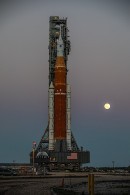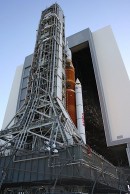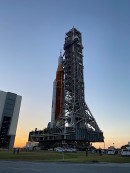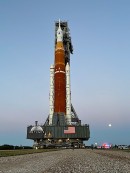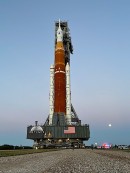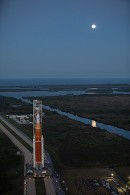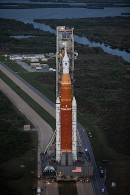There are presently few places on this Earth buzzing with so much activity and excitement as the Vehicle Assembly Building at the NASA Kennedy Space Center in Florida. Tucked away inside, the rocket and spaceship of the first ever Artemis mission are getting ready to take their place in the history books.
Scores of engineers are toiling to fix the issues experienced by the rocket during its wet dress rehearsal tests, fitting in the required gear for the actual launch, and inspecting the assembly for issues that might have been overlooked.
In an update on the progress of work on the Space Launch System rocket (SLS) and Orion capsule, NASA revealed the hydrogen tail service mast umbilical that experienced a leak during the test is now reconnected and shows no signs of leaking some more.
The inflatable seal between the mobile launcher’s crew access arm and Orion’s launch abort system, damaged by weather while the rocket was on the pad, was also replaced.
On the fitting front, the SLS now has its flight batteries on board, but also the command receiver decoders. Up next on the agenda are the flight closeout inspections, the removal of the access platforms, and the installation of flight doors.
Inside the Orion, engineers will fit the payloads that will fly to the Moon, including a dummy named Arturo Campos to play the role of an astronaut, and, in the purest of spaceflight traditions, a Snoopy doll to act as a zero gravity indicator.
NASA targets the Artemis I launch for August 29 at 8.33 a.m. EDT. If successful, the launch will put Orion on a 42-day mission to the Moon and back, with return scheduled for October 10.
If something gets in the way of the August 29 launch, the backup dates are September 2 and September 5.
In an update on the progress of work on the Space Launch System rocket (SLS) and Orion capsule, NASA revealed the hydrogen tail service mast umbilical that experienced a leak during the test is now reconnected and shows no signs of leaking some more.
The inflatable seal between the mobile launcher’s crew access arm and Orion’s launch abort system, damaged by weather while the rocket was on the pad, was also replaced.
On the fitting front, the SLS now has its flight batteries on board, but also the command receiver decoders. Up next on the agenda are the flight closeout inspections, the removal of the access platforms, and the installation of flight doors.
Inside the Orion, engineers will fit the payloads that will fly to the Moon, including a dummy named Arturo Campos to play the role of an astronaut, and, in the purest of spaceflight traditions, a Snoopy doll to act as a zero gravity indicator.
NASA targets the Artemis I launch for August 29 at 8.33 a.m. EDT. If successful, the launch will put Orion on a 42-day mission to the Moon and back, with return scheduled for October 10.
If something gets in the way of the August 29 launch, the backup dates are September 2 and September 5.


